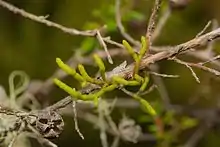Korthalsella salicornioides
Korthalsella salicornioides or dwarf mistletoe is an endemic parasitic plant in New Zealand.[1]
| Korthalsella salicornioides | |
|---|---|
 | |
| Korthalsella salicornioides on manuka | |
| Scientific classification | |
| Kingdom: | Plantae |
| Clade: | Tracheophytes |
| Clade: | Angiosperms |
| Clade: | Eudicots |
| Order: | Santalales |
| Family: | Santalaceae |
| Genus: | Korthalsella |
| Species: | K. salicornioides |
| Binomial name | |
| Korthalsella salicornioides | |
Description
Korthalsella salicornicoides is named after the succulent coastal plant Salicornia, because it has succulent stems. These appear as a dense mass of small fleshy leafless twigs, up to 10 cm long, usually growing on the host plants manuka (Leptospermum scoparium) and kanuka (Kunzea ericoides). It is reddish-yellow to green with tiny flowers and small yellow fruits from October to May.[2] It is similar to the other two species of New Zealand leafless mistletoe in the genus Korthalsella, but has denser stems arising at a narrower angle.
Conservation
This species is scattered across forests and scrublands in New Zealand, only abundant in small local patches.[3] In some areas it is threatened by felling of Leptospermum and Kunzea for firewood, farming, or exotic forestry.[2] It is classed as At Risk: Naturally Uncommon by the Department of Conservation.
References
- Sultan, Amir; Tate, Jennifer A.; de Lange, Peter J.; Glenny, David; Ladley, Jenny J.; Heenan, Peter; Robertson, Alastair W. (2018-04-03). "Host range, host specificity, regional host preferences and genetic variability of Korthalsella Tiegh. (Viscaceae) mistletoes in New Zealand". New Zealand Journal of Botany. 56 (2): 127–162. doi:10.1080/0028825X.2018.1464476. ISSN 0028-825X.
- "Korthalsella salicornioides | New Zealand Plant Conservation Network". www.nzpcn.org.nz. Retrieved 2016-05-31.
- Barkla, John (August 2020). "New exotic host for the dwarf mistletoe Korthalsella salicornioides" (PDF). Trilepidea. 201: 1.